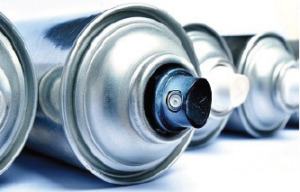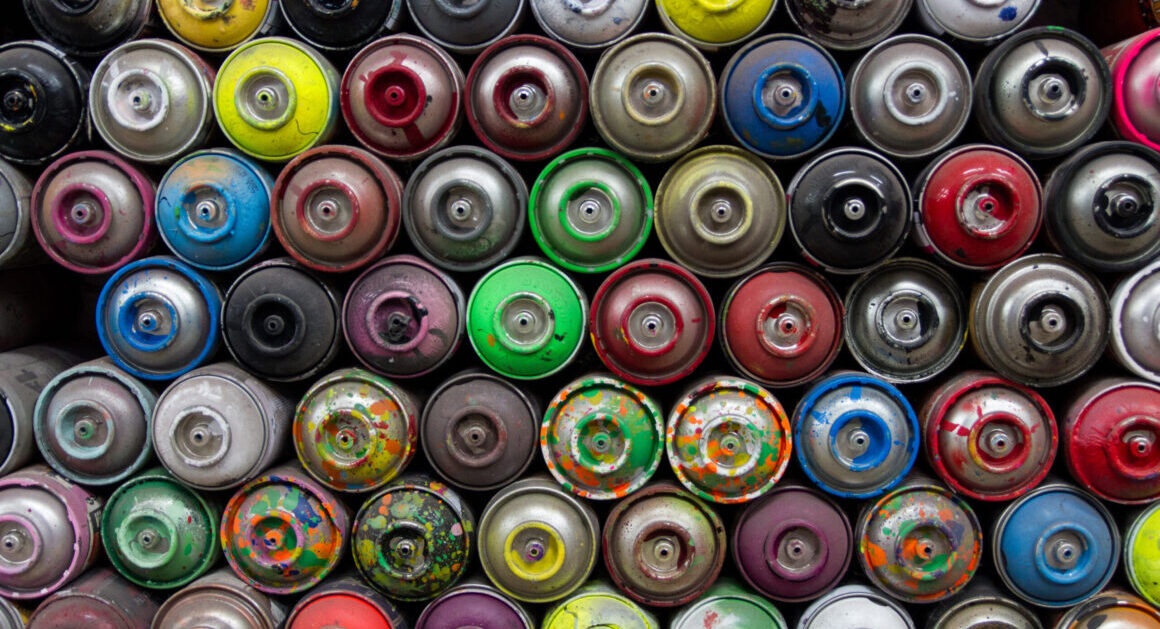Waste management has always been a challenge for our retail clients, especially those that also include medical clinics within their facilities. This special edition of Compliance News shares some updates regarding how to manage aerosol cans as a universal waste in the near future, as well as guidance on manifesting pharmaceutical waste.
Puncturing and draining aerosol cans
 On Feb. 7, hazardous waste aerosol cans will officially enter the national universal waste program. In addition to simplifying compliance with the hazardous waste regulations for handlers of hazardous waste aerosol cans, the EPA believes the rule will result in the diversion of large portions of these cans from landfilling to metal recycling. EPA regulations at 40 CFR 273.81 list eight factors for determining if a hazardous waste should qualify for the streamlined universal waste requirements. While it is not necessary for a waste to meet all these factors to enter the program, the agency determined that aerosol cans do satisfy each factor. As with all new rules, handlers will need to adjust to new requirements; one such requirement addresses the manner in which hazardous waste aerosol cans are to be punctured and drained prior to recycling.
On Feb. 7, hazardous waste aerosol cans will officially enter the national universal waste program. In addition to simplifying compliance with the hazardous waste regulations for handlers of hazardous waste aerosol cans, the EPA believes the rule will result in the diversion of large portions of these cans from landfilling to metal recycling. EPA regulations at 40 CFR 273.81 list eight factors for determining if a hazardous waste should qualify for the streamlined universal waste requirements. While it is not necessary for a waste to meet all these factors to enter the program, the agency determined that aerosol cans do satisfy each factor. As with all new rules, handlers will need to adjust to new requirements; one such requirement addresses the manner in which hazardous waste aerosol cans are to be punctured and drained prior to recycling.
Large and small quantity handlers
The final rule applies to both large and small quantity handlers of hazardous waste aerosol cans. Universal waste handlers are people who generate or produce universal waste as well as people who receive universal waste from other generators or handlers and consolidate it before sending it to another handler, recycler, or treatment, storage and disposal facility. The universal waste regulations define “large quantity handlers” as those that handle more than 5,000 kilograms (kg) of all universal waste at one time and “small quantity handlers” as those that handle 5,000 kg or less of all universal waste at one time. There are some differences in the regulations that apply to large quantity handlers and small quantity handlers, but the new requirements for puncturing and draining aerosol cans are the same for both categories of handlers.
No limits on handlers
In the final rule, the EPA notes that it had considered placing limits on handlers that puncture and drain aerosol cans received from off-site handlers. The concern was that there are so many types of aerosol cans that handlers may not be familiar with how to puncture and drain all cans safely. Based in part on information from the five states with universal waste rules for aerosol cans, the agency decided that the risks are not sufficient to justify such limits as long as handlers meet risk management measures.
Management requirements
Under the rule, both large and small quantity handlers that puncture and drain their aerosol cans must recycle the empty punctured cans and meet the following seven requirements:
- Conduct puncturing and draining using a device specifically designed to safely puncture aerosol cans and effectively contain the residual contents and any emissions. The agency had proposed that handlers puncture and drain aerosol cans only with commercial devices specifically designed to safely perform the action and effectively contain the residual contents, as well as any emissions from puncturing and draining. However, in the preamble of the final rule, the agency states that the handler must simply ensure that the device is designed or retrofitted according to accepted engineering practices based on established codes, standards, published technical reports, or similar peer-reviewed documents.
- Establish and follow a written procedure detailing how to safely puncture and drain the universal waste aerosol can (including proper assembly, operation and maintenance of the unit, segregation of incompatible wastes, and proper waste management practices to prevent fires or releases); maintain a copy of the manufacturer’s specification and instruction on-site; and ensure employees operating the device are trained in the proper procedures.
- Ensure that puncturing is done in a manner designed to prevent fires and release of any component of universal waste to the environment. This manner includes, but is not limited to, locating the equipment on a solid, flat surface in a well-ventilated area.
- Immediately transfer the contents from the waste aerosol can or puncturing device, if applicable, to a container or tank that meets the applicable requirements of 40 CFR 262.14, 262.15, 262.16, or 262.17. Essentially, this means that universal waste aerosol cans must be accumulated in containers that are structurally sound and compatible with the contents of the aerosol can and that show no evidence of leaks, spills, or damage that could cause leaks under reasonably foreseeable conditions.
- Conduct a hazardous waste determination on the contents of the emptied aerosol can per 40 CFR 262.11. Any hazardous waste generated as a result of puncturing and draining the aerosol can is subject to all applicable requirements of 40 CFR parts 260 through 272. The handler is considered the generator of the hazardous waste and is subject to 40 CFR part 262.
- If the contents are determined to be nonhazardous, the handler may manage the waste in any way that is in compliance with applicable federal, state, or local solid waste regulations.
- A written procedure must be in place in the event of a spill or leak, and a spill cleanup kit must be provided. All spills or leaks of the contents of the aerosol cans must be cleaned up promptly.
Manifesting hazardous waste pharmaceuticals
In February 2019, the EPA issued a final rule establishing a new set of regulations for the management of hazardous waste pharmaceuticals generated by healthcare facilities. There were several rationales behind the rule. For example, in contrast to staff at industrial facilities, healthcare personnel (e.g., doctors and nurses) are rarely trained to make hazardous waste determinations. Therefore, the EPA agreed with stakeholders that a special set of regulations was desirable so that “healthcare personnel focus on healthcare while still ensuring that hazardous waste is directed to proper management.”
While the new regulations (Subpart P of 40 CFR Part 266) are less extensive than the generator provisions in Part 262, some requirements are similar. Manifesting is one provision in the new subpart that is potentially confusing for healthcare facilities and reverse generators.
Here, we provide a list of requirements and other considerations that should be helpful to healthcare facilities manifesting under Subpart P. We also describe a recent EPA memo on Resource Conservation and Recovery Act (RCRA) codes for manifested hazardous waste pharmaceuticals and state requirements.
Compliance considerations
- The manifesting requirements apply to noncreditable hazardous waste pharmaceuticals, defined as “a prescription hazardous waste pharmaceutical that does not have a reasonable expectation to be eligible for manufacturer credit or a nonprescription hazardous waste pharmaceutical that does not have a reasonable expectation to be legitimately used/reused or reclaimed.”
- Healthcare facilities are not required to use a hazardous waste manifest or a hazardous waste transporter when shipping potentially creditable hazardous waste pharmaceuticals to a reverse distributor.
- The manifesting requirements apply to large quantity generators (LQGs) and small quantity generators (SQGs). Very small quantity generators (VSQGs) are not required to provide manifests for their shipments of hazardous waste pharmaceuticals. In other words, the regulations apply to all healthcare facilities that generate above any of the VSQG monthly quantity thresholds.
- A reverse distributor is any person who receives and accumulates prescription pharmaceuticals that are potentially creditable hazardous waste pharmaceuticals for the purpose of facilitating or verifying manufacturer credit.
- Manifests are required for evaluated hazardous waste pharmaceuticals reverse distributors ship off-site as hazardous waste. (An evaluated hazardous waste pharmaceutical is defined as a prescription hazardous waste pharmaceutical that has been evaluated by a reverse distributor and will not be sent to another reverse distributor for further evaluation or verification of manufacture credit.)
- The healthcare facility or the reverse distributor must ship the manifested hazardous waste pharmaceuticals to a RCRA-designated facility, such as an interim-status or a permitted transfer, storage, and disposal facility (TSDF).
- A healthcare facility must keep a copy of the signed manifest for at least 3 years from the date the shipment was accepted by the initial transporter.
- Healthcare facilities must submit an exception report to the EPA’s Regional Administrator if they have not received a signed copy of the manifest within 60 days of the initial transporter accepting the shipment. The agency may require a healthcare facility to furnish additional reports regarding the quantity and disposition of noncreditable hazardous waste pharmaceuticals. The facility must keep a copy of any exception report for at least three years from the date of the report.
Waste codes
 The February 2019 final rule allowed that, in lieu of including all applicable waste codes on the manifest, a healthcare facility must include the six-letter word PHARMS in item 13 of the manifest. The EPA assumed that facilities would use the agency’s electronic manifesting (e-Manifest) system when shipping hazardous waste pharmaceuticals. The agency subsequently learned that most facilities are still using paper manifests, which allow for only four-character waste codes.
The February 2019 final rule allowed that, in lieu of including all applicable waste codes on the manifest, a healthcare facility must include the six-letter word PHARMS in item 13 of the manifest. The EPA assumed that facilities would use the agency’s electronic manifesting (e-Manifest) system when shipping hazardous waste pharmaceuticals. The agency subsequently learned that most facilities are still using paper manifests, which allow for only four-character waste codes.
The agency also found that the databases used by some states and industry stakeholders are not designed to accommodate six characters, which makes it difficult to exchange data with the e-Manifest system. Accordingly, in its memo, the agency states that it is allowing the use of a four-character code — PHRM — or the PHARMS code on both paper and e-Manifests.
The memo also indicates that nothing prevents a healthcare facility from including specific waste codes on the manifest, in addition to PHARMS or PHRM.
“Including all applicable RCRA hazardous waste codes on the manifest when shipping non-creditable hazardous waste pharmaceuticals could help the receiving facility better understand the wastes and determine the best course of management,” states the agency, which adds:
“In addition, we recommend for manifested non-creditable hazardous waste pharmaceuticals shipped from a healthcare facility operating under subpart P but passing through a state or going to a TSDF in a state that has not yet adopted subpart P, that the healthcare facility/vendor check with those states regarding whether they require all applicable waste codes to be on the manifest. Further, the regulated community should be aware that as authorized states adopt and become authorized for Part 266 Subpart P, it is possible that they may choose to be more stringent and require all hazardous waste codes when healthcare facilities manifest non-creditable hazardous waste pharmaceuticals.”


